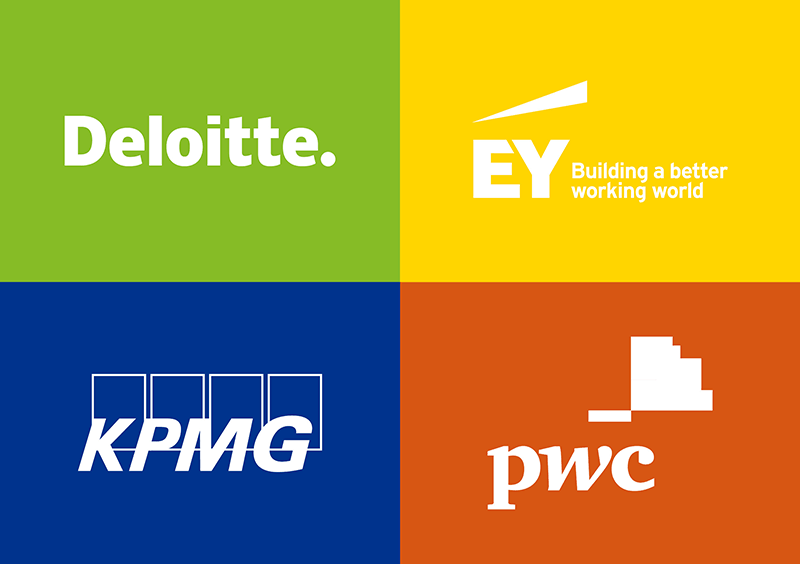
Introduction to the Big 4

You will have heard about the Big Four and probably can even name them if you work in the Wharf. But what exactly are EY, KPMG, Deloitte and PwC doing and why are they so important? Well, they are definitely big with revenues of $35-60bn and 250-400,000 employees each. A bit tongue in check, but if they were countries, each of the Big 4 would be among the 100 largest countries in terms of GDP. Their combined 2022 revenue of almost $190bn would place them just shy of a spot in the top 50.
While most people know the Big 4 as accountancy firms (and usually as the ones with the highest prestige and the highest fees), they have steadily expanded the range of their services. As the best consultants in the field, the Big Four enjoy a high level of trust, so used this brand imagine to expand into other areas.
Financial advice, tax and transaction advisory are logical extensions of accounting. Nowadays, all of the Big Four also offer management/strategy consulting, legal advice, IT consulting, outsourcing and some more. As with other areas of consulting, there is a hint of body hire as well, especially for longer running engagements. Audit and accounting accounts for less than a third of their revenues. After all, n audit is an audit and does not give you lots of room to grow an account apart from raising your fees whereas management consulting can easily grow by 10x in a short period of time. There are also regulatory limits of what you can offer to accounting clients as there is the risk of (sophisticated) blackmail – “we will only sign off your accounts if you buy x millions of consulting services from us”. Scaling is also easier as consulting staff does not need to pass professional exams. Although most of the firms are better known by their acronyms, all Big 4 companies are the result of multiple mergers, mostly of accountancy firms which their current somewhat longish names reflect.
- EY is the trade name for Ernst & Young; in 1989, Ernst & Whinney merged with the fifth largest firm globally back then, Arthur Young & Co., to create Ernst & Young
- KPMG stands for Klynveld Peat Marwick Goerdeler - no doubt a fun fact that will give you a round of applause at every party with accountants present; it is the result of the merger of KMG (Klynveld Main Goerdeler) and Peat Marwick in 1987
- Deloitte – is actually Deloitte Touche Tohmatsu and was founded by William Welch Deloitte, but went through a number of mergers, the namesake ones with Tohmatsu Aoki & Co in 1975 and Touche Ross in 1989
- PwC – most will know it as PricewaterhouseCoopers; it was created in 1998 by a merger between two larger accounting firms: Coopers & Lybrand and Price Waterhouse
A particularity is that the Big Four are not one big corporation, but somewhat loose connections of national offices, often with a Swiss Verein association) as the head organisation. Think of it as a franchise model rather than one big corporation with a clearly defined hierarchy.
Similar to most consulting firms, the Big Four companies are owned by (equity) partners. This can make decision-finding lengthy and also mean that local offices can have different policies and standards. There is a nominal CEO, but this is more a first among equals, a (senior) manager elected by its peers, but without the powers of a CEO in industry. The drama around EY’s Project Everest https://www.bbc.co.uk/news/65247525 will give you an idea of this. The proposed split between the lucrative consulting part and lower margin, but more predictable accounting part was eventually called off after 18 months of deliberations between the 13,000 partners and cost of ca. $100m. A partner-led model also means that the Big 4 are poised to grow – you only make it to partner if you acquire additional business.
Below them in the accounting pecking order, you will find the Next 10 with companies like BDO, Baker Tilly, Mazars, Grant Thornton. They are smaller and sometimes lack the global network of the Big 4, but charge considerably lower fees for (very) similar work which you will like as a client.
The Big Four have come under quite a bit of criticism lately. One issue is structural, the “Four” gives it away – they are obviously an oligopoly which can set fees and influence accounting standards. There is also not much choice – imagine valuation support for an M&A transaction: one company will work for the seller which leaves three for potential bidders. It might well be that one does not have capacity or (especially for smaller companies or niche industries) no expertise. Chinese walls (i.e. having strictly separated teams work on the same transaction) can be a solution, but do not work perfectly, especially in smaller offices, people tend to talk to each other.
There is also the criticism that accountants tend to look the other way if they do not want to lose a mandate (or do more business with a company) and are not as strict as they should be. EY abysmal record in the Wirecard scandal is a good example when they failed to detect billions of bogus transactions. It was one of the rare examples when there were actual consequences for auditors https://www.reuters.com/world/europe/german-regulator-hands-ey-2-year-audit-ban-over-wirecard-scandal-handelsblatt-2023-04-03/ - although some observers said that it was a more slap on the wrist given the extent of the damage. All Big Four companies were involved in the 1MDB scandal as well. In the UK, they were accused of profiteering from Covid https://news.sky.com/story/pwc-partners-land-record-920-000-payouts-as-pandemic-revenue-surge-continues-12647509 And the list goes on and on, so it is likely to be a structural problem rather than a few rotten apples.
There is movement in the industry and some of the smaller firms are making strides https://www.ft.com/content/57e0ff80-de17-48b1-9da7-5bdbaaad8898, so it will be interesting to see what happens next. Further consolidation is unlikely, a forced reduction to accounting only companies will make them less attractive as employers. There is more scrutiny https://www.wsj.com/articles/u-k-government-looks-to-limit-dominance-of-big-four-audit-firms-11654029340 – if you read annual reports, you will see some information on how much non-accounting business the company is buying from its accountants. Mandatory rotation means that companies need to rotate their auditors after a certain period of time (there were some cases of partners simply switching companies and taking clients with them).
Introduction to the Big 4
You will have heard about the Big Four and probably can even name them if you work in the Wharf. But what exactly are EY, KPMG, Deloitte and PwC doing and why are they so important? Well, they are definitely big with revenues of $35-60bn and 250-400,000 employees each. A bit tongue in check, but if they were countries, each of the Big 4 would be among the 100 largest countries in terms of GDP. Their combined 2022 revenue of almost $190bn would place them just shy of a spot in the top 50.
While most people know the Big 4 as accountancy firms (and usually as the ones with the highest prestige and the highest fees), they have steadily expanded the range of their services. As the best consultants in the field, the Big Four enjoy a high level of trust, so used this brand imagine to expand into other areas.
Financial advice, tax and transaction advisory are logical extensions of accounting. Nowadays, all of the Big Four also offer management/strategy consulting, legal advice, IT consulting, outsourcing and some more. As with other areas of consulting, there is a hint of body hire as well, especially for longer running engagements. Audit and accounting accounts for less than a third of their revenues. After all, n audit is an audit and does not give you lots of room to grow an account apart from raising your fees whereas management consulting can easily grow by 10x in a short period of time. There are also regulatory limits of what you can offer to accounting clients as there is the risk of (sophisticated) blackmail – “we will only sign off your accounts if you buy x millions of consulting services from us”. Scaling is also easier as consulting staff does not need to pass professional exams. Although most of the firms are better known by their acronyms, all Big 4 companies are the result of multiple mergers, mostly of accountancy firms which their current somewhat longish names reflect.
- EY is the trade name for Ernst & Young; in 1989, Ernst & Whinney merged with the fifth largest firm globally back then, Arthur Young & Co., to create Ernst & Young
- KPMG stands for Klynveld Peat Marwick Goerdeler - no doubt a fun fact that will give you a round of applause at every party with accountants present; it is the result of the merger of KMG (Klynveld Main Goerdeler) and Peat Marwick in 1987
- Deloitte – is actually Deloitte Touche Tohmatsu and was founded by William Welch Deloitte, but went through a number of mergers, the namesake ones with Tohmatsu Aoki & Co in 1975 and Touche Ross in 1989
- PwC – most will know it as PricewaterhouseCoopers; it was created in 1998 by a merger between two larger accounting firms: Coopers & Lybrand and Price Waterhouse
A particularity is that the Big Four are not one big corporation, but somewhat loose connections of national offices, often with a Swiss Verein association) as the head organisation. Think of it as a franchise model rather than one big corporation with a clearly defined hierarchy.
Similar to most consulting firms, the Big Four companies are owned by (equity) partners. This can make decision-finding lengthy and also mean that local offices can have different policies and standards. There is a nominal CEO, but this is more a first among equals, a (senior) manager elected by its peers, but without the powers of a CEO in industry. The drama around EY’s Project Everest https://www.bbc.co.uk/news/65247525 will give you an idea of this. The proposed split between the lucrative consulting part and lower margin, but more predictable accounting part was eventually called off after 18 months of deliberations between the 13,000 partners and cost of ca. $100m. A partner-led model also means that the Big 4 are poised to grow – you only make it to partner if you acquire additional business.
Below them in the accounting pecking order, you will find the Next 10 with companies like BDO, Baker Tilly, Mazars, Grant Thornton. They are smaller and sometimes lack the global network of the Big 4, but charge considerably lower fees for (very) similar work which you will like as a client.
The Big Four have come under quite a bit of criticism lately. One issue is structural, the “Four” gives it away – they are obviously an oligopoly which can set fees and influence accounting standards. There is also not much choice – imagine valuation support for an M&A transaction: one company will work for the seller which leaves three for potential bidders. It might well be that one does not have capacity or (especially for smaller companies or niche industries) no expertise. Chinese walls (i.e. having strictly separated teams work on the same transaction) can be a solution, but do not work perfectly, especially in smaller offices, people tend to talk to each other.
There is also the criticism that accountants tend to look the other way if they do not want to lose a mandate (or do more business with a company) and are not as strict as they should be. EY abysmal record in the Wirecard scandal is a good example when they failed to detect billions of bogus transactions. It was one of the rare examples when there were actual consequences for auditors https://www.reuters.com/world/europe/german-regulator-hands-ey-2-year-audit-ban-over-wirecard-scandal-handelsblatt-2023-04-03/ - although some observers said that it was a more slap on the wrist given the extent of the damage. All Big Four companies were involved in the 1MDB scandal as well. In the UK, they were accused of profiteering from Covid https://news.sky.com/story/pwc-partners-land-record-920-000-payouts-as-pandemic-revenue-surge-continues-12647509 And the list goes on and on, so it is likely to be a structural problem rather than a few rotten apples.
There is movement in the industry and some of the smaller firms are making strides https://www.ft.com/content/57e0ff80-de17-48b1-9da7-5bdbaaad8898, so it will be interesting to see what happens next. Further consolidation is unlikely, a forced reduction to accounting only companies will make them less attractive as employers. There is more scrutiny https://www.wsj.com/articles/u-k-government-looks-to-limit-dominance-of-big-four-audit-firms-11654029340 – if you read annual reports, you will see some information on how much non-accounting business the company is buying from its accountants. Mandatory rotation means that companies need to rotate their auditors after a certain period of time (there were some cases of partners simply switching companies and taking clients with them).




